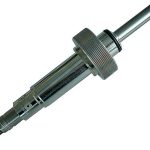Hamilton first introduced the ARC system at Achema 2009 in Frankfurt. This concept led to a paradigm shift in process analysis because ARC integrates the transmitter in the sensors, resulting in a direct link between the process data and the process control system. In the meantime, not only three different ARC solutions but also numerous sensors are available for the most varied applications and requirements in process analysis.
When Hamilton Bonaduz originally presented its exciting innovation, a certain amount of work was required to convince sales partners, process analysts and sensor experts. Some thought that abandoning the accustomed configuration comprised of a sensor, transmitter and display or control unit was too revolutionary. “We sent out a strong signal with ARC, which has since proven itself and set the market in motion”, is how Dr. Jörg Pochert summed up the introductory phase. He is Vice President Laboratory & Sensors at the Swiss Bonaduz location and responsible for Hamilton’s global process analysis portfolio.
Pochert was not at all surprised by the success of the ARC system in the market, because in his estimation the multiple advantages of the new technology speak for themselves. The number of interfaces has been reduced by integrating the transmitter, and the quality and integrity of the measured values stepped up. The option of connecting different sensor types successively without having to reconfigure simplifies the work process, and the effort for maintenance is likewise down. The leaner processes can add up to savings of between 20 to 50 % compared to standard systems. The usual restrictions due to moisture, cable lengths or other signal disturbances are a thing of the past. In addition, intelligent functions like diagnostics, process history and calibration data are directly integrated in the ARC sensors.
“Furthermore, we designed the ARC system for the needs of specific user groups right from the start”, explained Pochert referring to the development process. After extensive market research, the Hamilton experts developed clusters of demand types which resulted in three different variants of the ARC system:
ARC Vital as the basic solution for classic users with a direct connection from the sensors to a control system via a 4 to 20 mA interface
ARC Versa with an analogue interface from a maximum of 30 sensors to the control system as well as wireless communication between the sensors and the ARC View console
ARC Vision, the high-end alternative especially for new systems in which the sensors communicate digitally with the control system over a Modbus and are operated wirelessly using ARC View
“The demand for ARC Versa is particularly high, not only in biopharmaceutical applications. The other two variants also meet a clear market need. Manufacturers of engineering plant and special machinery, for example, who are usually very familiar with the Modbus stand-ard and have to integrate a large number of sensors into compact systems, regard ARC Vision as a good way to reduce production costs”, Pochert concluded when asked to describe reactions in the market.
New, electrochemical ARC sensors
The ARC system should experience another boost in the next few months because Hamilton recently extended the sensor series for its successful line. Four electrochemical sensors for use in biotechnology and pharmaceutical production, trace measurements and measurements at high CO2 partial pressure have now been added to the range along with sensors for measuring conductivity in ultra pure water. The Oxyferm FDA ARC sensor is designed for electrochemical oxygen measurements in fermentation processes as well as for the production of pharmaceuticals. The Oxygold G ARC is used to measure slight oxygen traces in watery so-lutions. The Oxygold B ARC measures oxygen traces in the presence of CO2, especially in the beverage industry. Last but not least, the Conducell PWSE ARC sensor with a triclamp process connection monitors the quality of ultra pure water in industrial processes. Its measurement range is from 0.01 to 2000 µS/cm, which makes the sensor ideal for water production in the pharmaceutical industry and power plants. All ARC sensors feature fully compensated, intelligent measuring signals at two analogue 4 to 20 mA outputs, a digital Modbus interface and wireless data transmission via the optional ARC Wi sensor adapter. All new sensors are 100 % compatible with the existing ARC product family.
cpp-net.com/0112417
Share:








